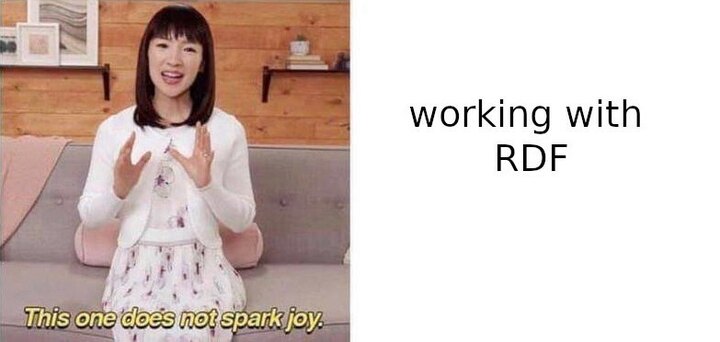
I want to say it all started with a rather offensive tweet, but it wouldn't be true. No, it all started with my curiosity to please the Google Structured Data testing tool1. Last year, in August, I added microdata to my website - it was more or less straightforward to do so.
Except it was ugly, and, after half a year, I'm certain to say, quite useless. I got no pretty Google cards - maybe because I refuse to do AMP2, maybe because I'm not important enough, who knows. But by the time I was reaching this conclusion, that aforementioned tweet happened, and I got caught up in Semantic Hell, also known as arguing about RDF.
The first time I heard about the Semantic Web collided with the dawn of the web 2.0 hype, so it wasn't hard to dismiss it when so much was happening. I was rather new to the whole web thing, and most of the academic discussions were not even available in Hungarian.
In that thread, it pointed was out to me that what I have on my site is microdata, not RDFa - I genuinely thought they are more or less interchangeable: both can use the same vocabulary, so it shouldn't really matter which HTML properties I use, should it? Well, it does, but I believe the basis for my confusion can be found in the microdata description: it was an initiative to make RDF simple enough for people making websites.
If you're just as confused as I was, in my own words:
- RDF is a ruleset framework, which is only used to describe sets of rules
- these rules are named vocabularies: Schema.org, Dublin Core, Open Graph (the not-invented-here is strong in Facebook), FOAF (for the sake of your own sanity, don't read the FOAF doc, unless you already know how to greet Shub-Niggurath or what geekcode is/was), etc
- if you try to use multiple vocabularies at once - which you can -, it will be incredibly hard to remember when to use what
- a vocabulary is what you can actually add to your data - machines then go to the RDF definition of the vocabulary make databases out of the data
- microdata is
itemprop,itemscope,itemtypeanditemrefHTML5 attributes - whereas RDFa is
vocab,typeof,propertyHTML5 attributes - if you want to please academics or some sort of internal tool that is built to utilize RDF, use RDFa - I keep asking if RDFa vocabularies, such as Dublin Core, are consumed by anything on the public internet, but I keep getting answers3 with no actual answers
- if you're doing this for a search engine, stick to microdata, it's less prone to errors
- ... or instead of both, just do JSON-LD, which is
JSON with special keys:
@context, which points to a vocabulary, and@type, which points you to a vocabulary element, and these two define what your data keys should be named and what kind of data they might contain
With all this now known, I tried to turn mark up my content as microformats v1, microformats v2, and RDFa.
I already had errors with microdata...
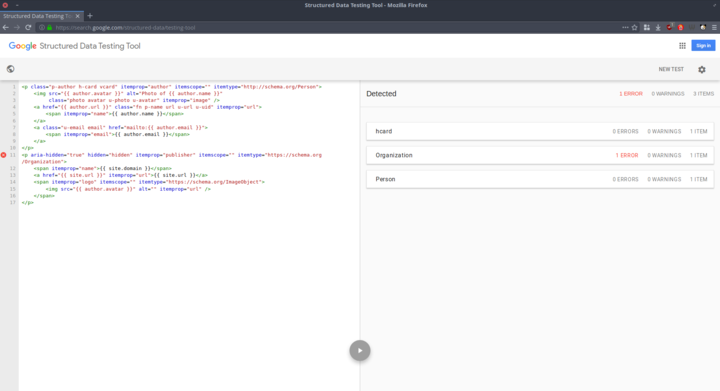
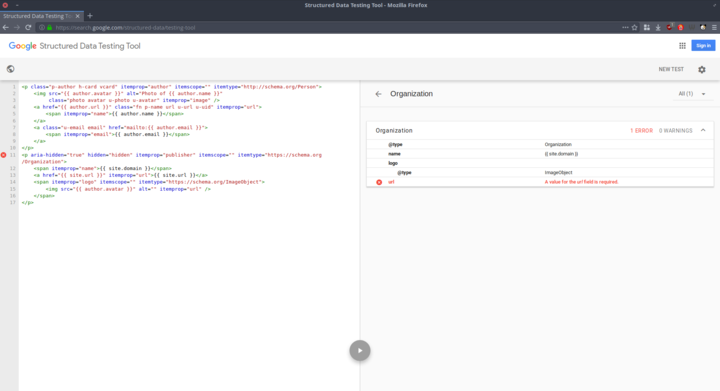
...but those errors then became ever more peculiar problems with RDFa...
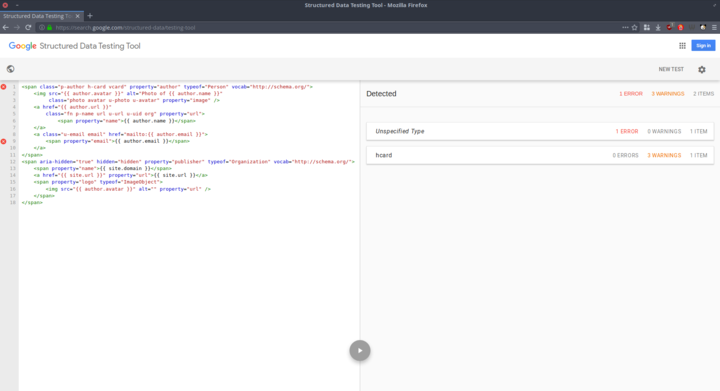
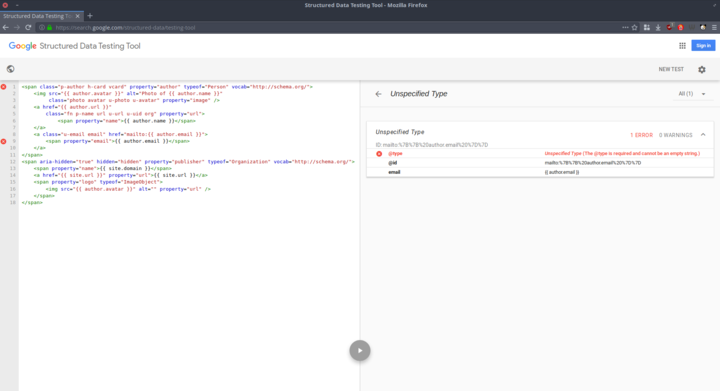
... while microformats v1 was parsed without any glitches.
Sidenote: microformats (v1 and v2), unlike the
previous things, are extra HTML class data, and v1 is still
parsed by most search engines.
At this point I gave up on RDFa and moved over to test JSON-LD.
It's surprisingly easy to represent data in JSON-LD with schema.org context (vocabulary, why on earth was vocabulary renamed to context?! Oh. Because we're in hell.). There's a long entry about why JSON-LD happened4 and it has a lot of reasonable points.
What it forgets to talk about is that JSON-LD is an invisible duplication of what is either already or what should be in HTML. It's a decent way to store data, to exchange data, but not to present it to someone on the other end of the cable.
The most common JSON-LD vocabulary, Schema.org has it's own interesting world of problems. It wants to be a single point of entry, one gigantic vocabulary, for anything web, a humongous task and noble goal. However, it's still lacking a lot of definitions (ever tried to represent a resume with it?), it has weird quirks ('follows' on a Person can only be another Person, it can't be a Brand, a WebSite, or a simple URL) and it's driven heavily by Google (most people working on it are working at Google).
I ended up with compromises.
<html lang="en" prefix="og: http://ogp.me/ns# article: http://ogp.me/ns/article#">
<head>
<title>A piece of Powerscourt Waterfall - petermolnar.net</title>
<!-- JSON-LD as alternative -->
<link rel="alternate" type="application/json" title="a-piece-of-powerscourt-waterfall JSON-LD" href="https://petermolnar.net/a-piece-of-powerscourt-waterfall/index.json" />
<!-- Open Graph vocabulary RDFa -->
<meta property="og:title" content="A piece of Powerscourt Waterfall" />
<meta property="og:type" content="article" />
<meta property="og:url" content="https://petermolnar.net/a-piece-of-powerscourt-waterfall/" />
<meta property="og:description" content="" />
<meta property="article:published_time" content="2017-11-09T18:00:00+00:00" />
<meta property="article:modified_time" content="2019-01-05T11:52:47.543053+00:00" />
<meta property="article:author" content="Peter Molnar (mail@petermolnar.net)" />
<meta property="og:image" content="https://petermolnar.net/a-piece-of-powerscourt-waterfall/a-piece-of-powerscourt-waterfall_b.jpg" />
<meta property="og:image:type" content="image/jpeg" />
<meta property="og:image:width" content="1280" />
<meta property="og:image:height" content="847" />
<!-- the rest of meta and header elements -->
<!-- followed by the content, with microformats v1 and v2 markup -->HTML provides an interesting functionality, the
rel=alternate. This is meant to be the representation of
the same data, but in another format. The most common use is links to
RSS and Atom feeds.
I don't know if Google will consume the JSON-LD alternate format, but it's there, and anyone can easily use it.
As for RDFa, I turned to meta elements. Unlike with
JSON-LD, I decided to use the extremely simple vocabulary of Open Graph
- at least Facebook is known to consume that.
The tragedy of this whole story: HTML5 has so many tags that is should be possible to do structured data without any need for any of the things above.
My content is now:
- microformats v1 and v2 within the visible content
- a minimal RDFa in
metatags - a sidecar JSON-LD version
This way it's simple, but compatible enough for most cases.
Footnotes
Out of the blue, Maria from 3WhiteHats pinged me with an article of their on how to do structured data on your site5 - it's useful, and it's good, especially the troubleshooting at the bottom of the entry.
(Oh, by the way: this entry was written by Peter Molnar, and originally posted on petermolnar dot net.)
Responses from the internet
https://quickthoughts.jgregorymcverry.com/2019/02/11/great-post-you-helped-me-understand-some